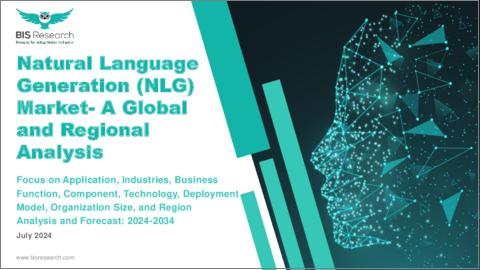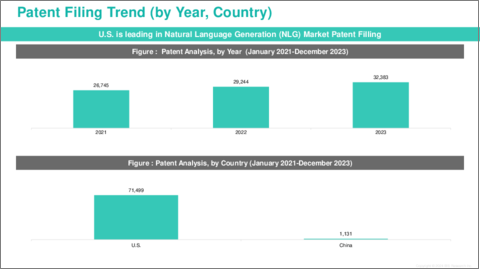|
|
市場調査レポート
商品コード
1518219
自然言語生成(NLG)市場- 世界および地域別分析:用途別、業界別、ビジネス機能別、コンポーネント別、技術別、展開モデル別、組織規模別、地域別 - 分析と予測(2024年~2034年)Natural Language Generation (NLG) Market - A Global and Regional Analysis: Focus on Application, Industries, Business Function, Component, Technology, Deployment Model, Organization Size, and Region - Analysis and Forecast, 2024-2034 |
||||||
カスタマイズ可能
|
|||||||
| 自然言語生成(NLG)市場- 世界および地域別分析:用途別、業界別、ビジネス機能別、コンポーネント別、技術別、展開モデル別、組織規模別、地域別 - 分析と予測(2024年~2034年) |
|
出版日: 2024年07月23日
発行: BIS Research
ページ情報: 英文 100 Pages
納期: 1~5営業日
|
- 全表示
- 概要
- 目次
自然言語生成(NLG)の市場規模は、さまざまな市場促進要因に後押しされ、大きな成長を遂げています。
楽観的シナリオでは、市場は2024年に11億8,000万米ドルになるとみられ、CAGR 19.20%で拡大し、2034年には68億6,000万米ドルに達すると予測されています。
| 主要市場統計 | |
|---|---|
| 予測期間 | 2024年~2034年 |
| 2024年の評価 | 11億8,000万米ドル |
| 2034年の予測 | 68億6,000万米ドル |
| CAGR | 19.2% |
この成長の主な促進要因は、高度な人工知能と機械学習技術の統合が進んでいることです。これらの技術はNLGの機能を強化し、データから直接、より洗練された、文脈を意識したテキストコンテンツの作成を可能にします。この変革は、金融、ヘルスケア、メディアなどさまざまな業界において、コンテンツ制作の自動化に対する需要が高まっていることによってさらに促進され、プロセスのスピードアップだけでなく、コストの削減や精度の向上にもつながっています。企業が自動化された洞察とレポート作成の利点を認識し続けるにつれ、NLGソリューションの採用は加速し、企業がデータとどのように接し、そこから価値を引き出すかを再構築すると予想されます。
NLG市場の成長に寄与するもう1つの促進要因は、パーソナライズされたターゲットコミュニケーションのニーズの高まりです。消費者がさまざまなタッチポイントでカスタマイズされた体験を求めるようになっているため、企業はNLGを活用してカスタマイズされたコンテンツを大規模に生成するようになっています。これにより、企業は個々の嗜好や行動に共鳴するメッセージを配信し、より効果的に視聴者を取り込むことができます。
当レポートでは、世界の自然言語生成(NLG)市場について調査し、市場の概要とともに、用途別、業界別、ビジネス機能別、コンポーネント別、技術別、展開モデル別、組織規模別、地域別の動向、および市場に参入する企業のプロファイルなどを提供しています。
目次
エグゼクティブサマリー
第1章 市場:業界の展望
- 動向:現在および将来の影響評価
- サプライチェーンの概要
- R&Dレビュー
- 規制状況
- ステークホルダー分析
- 主要な世界的イベントの影響分析
- 市場力学の概要
第2章 自然言語生成(NLG)市場(用途別)
- 用途のセグメンテーション
- 用途の概要
- 自然言語生成(NLG)市場(用途別)
- 自然言語生成(NLG)市場(業界別)
- 自然言語生成(NLG)市場(ビジネス機能別)
第3章 自然言語生成(NLG)市場(製品別)
- 製品セグメンテーション
- 製品概要
- 自然言語生成(NLG)市場(コンポーネント別)
- 自然言語生成(NLG)市場(技術別)
- 自然言語生成(NLG)市場(展開モデル別)
- 自然言語生成(NLG)市場(組織規模別)
第4章 自然言語生成(NLG)市場(地域別)
- 自然言語生成(NLG)市場(地域別)
- 北米
- 欧州
- アジア太平洋
- その他の地域
第5章 企業プロファイル
- 今後の見通し
- 地理的評価
- ARRIA NLG Limited
- AWS
- IBM
- Narrative Science
- Automated Insights
- Narrativa
- Yseop
- Retresco
- Artifical Solutions
- Phrasee
- AX Semantics
- CoGen Tex
- Phrasetech
- NewsRx
- Conversica
第6章 調査手法
Introduction to Global Natural Language Generation (NLG) Market
The natural language generation (NLG) market is undergoing significant growth, propelled by various key factors and market drivers. In an optimistic scenario, the market is evaluated at a valuation of $1.18 billion in 2024 and is projected to expand at a CAGR of 19.20% to reach $6.86 billion by 2034.
| KEY MARKET STATISTICS | |
|---|---|
| Forecast Period | 2024 - 2034 |
| 2024 Evaluation | $1.18 Billion |
| 2034 Forecast | $6.86 Billion |
| CAGR | 19.2% |
A primary driver for this growth is the increasing integration of advanced artificial intelligence and machine learning technologies. These technologies enhance the NLG capabilities, enabling the creation of more sophisticated, contextually aware textual content directly from data. This transformation is further fueled by the growing demand across various industries such as finance, healthcare, and media for automating content production, which not only speeds up the process but also reduces costs and improves accuracy. As companies continue to recognize the benefits of automated insights and report generation, the adoption of NLG solutions is expected to accelerate, reshaping how businesses interact with data and derive value from it.
Another driving factor contributing to the growth of the NLG market is the rising need for personalized and targeted communication. With consumers increasingly expecting tailored experiences across various touchpoints, businesses are leveraging NLG to generate customized content at scale. This enables companies to engage their audience more effectively, delivering messages that resonate with individual preferences and behaviors.
Furthermore, in terms of major leading companies driving innovation in the NLG space, stalwarts such as OpenAI, Arria NLG, and Narrative Science continue to push the boundaries of what's possible with automated content generation. These companies invest heavily in research and development to enhance the capabilities of NLG systems, making them more intuitive, adaptable, and capable of understanding nuanced contexts. Additionally, tech giants including Google, Microsoft, and IBM are integrating NLG functionalities into their broader suite of AI-powered services, democratizing access to advanced language generation capabilities for businesses of all sizes.
Overall, the NLG market's remarkable growth trajectory is propelled by a convergence of factors, including advancements in AI and machine learning technologies, increasing demand for automated content production across industries, the need for personalized communication, and the growing importance of extracting insights from big data. With leading companies driving innovation and adoption, NLG is poised to revolutionize how businesses interact with data and leverage the power of language to drive value and competitive advantage.
Market Segmentation:
Segmentation 1: by Application
- Customer Experience Management
- Fraud Detection and Anti-money Laundering
- Risk and Compliance Management
- Performance Management
- Predictive Maintenance
- Others
Segmentation 2: by Industries
- Banking, Financial Services, and Insurance (BFSI)
- Retail and eCommerce
- Government and Defense
- Healthcare and Life Sciences
- Manufacturing
- Energy and Utilities
- Telecom and IT
- Media and Entertainment
- Others
Segmentation 3: by Business Function
- Finance
- Legal
- Operations
- HR
- Marketing and Sales
Segmentation 4: by Component
- Software
- Services
- Managed Services
- Professional Services
Segmentation 5: by Technology
- Rule-Based NLG
- Statistical NLG
- Hybrid NLG
Segmentation 6: by Deployment Model
- On-Premises
- Cloud
Segmentation 7: by Organization Size
- Small and Medium-sized Enterprises (MSE)
- Large Enterprises
Segmentation 8: by Region
- North America
- Europe
- Asia-Pacific
- Rest-of-the-World
How can this report add value to an organization?
Product/Innovation Strategy: The global natural language generation (NLG) market has been extensively segmented based on various categories, such as application, industries, business function, component, technology, deployment model, and organization size. This can help readers get a clear overview of which segments account for the largest share and which ones are well-positioned to grow in the coming years.
Competitive Strategy: A detailed competitive benchmarking of the players operating in the global natural language generation (NLG) market has been done to help the reader understand how players stack against each other, presenting a clear market landscape. Additionally, comprehensive competitive strategies such as partnerships, agreements, and collaborations will aid the reader in understanding the untapped revenue pockets in the market.
Key Market Players and Competition Synopsis
The companies that are profiled have been selected based on thorough secondary research, which includes analyzing company coverage, product portfolio, market penetration, and insights gathered from primary experts.
Some of the prominent companies in this market are:
- ARRIA NLG Limited
- Yseop
- Narrative Science
- IBM
- AWS
- Retresco
- Conversica
- Phrasetech
Key Questions Answered in this Report:
- What are the main factors driving the demand for natural language generation (NLG) market?
- What are the major patents filed by the companies active in the natural language generation (NLG) market?
- Who are the key players in the natural language generation (NLG) market, and what are their respective market shares?
- What partnerships or collaborations are prominent among stakeholders in the natural language generation (NLG) market?
- What are the strategies adopted by the key companies to gain a competitive edge in natural language generation (NLG) market?
- What is the futuristic outlook for the natural language generation (NLG) market in terms of growth potential?
- What is the current estimation of the natural language generation (NLG) market and what growth trajectory is projected from 2024 to 2034?
- Which application, and product segment is expected to lead the market over the forecast period (2024-2034)?
- Which regions demonstrate the highest adoption rates for natural language generation (NLG) market, and what factors contribute to their leadership?
Table of Contents
Executive Summary
Scope and Definition
Market/Product Definition
Key Questions Answered
Analysis and Forecast Note
1. Markets: Industry Outlook
- 1.1 Trends: Current and Future Impact Assessment
- 1.2 Supply Chain Overview
- 1.2.1 Value Chain Analysis
- 1.2.2 Pricing Forecast
- 1.3 R&D Review
- 1.3.1 Patent Filing Trend by Country, by Company
- 1.4 Regulatory Landscape
- 1.5 Stakeholder Analysis
- 1.5.1 Use Case
- 1.5.2 End User and Buying Criteria
- 1.6 Impact Analysis for Key Global Events
- 1.7 Market Dynamics Overview
- 1.7.1 Market Drivers
- 1.7.2 Market Restraints
- 1.7.3 Market Opportunities
2. Natural Language Generation (NLG) Market (by Application)
- 2.1 Application Segmentation
- 2.2 Application Summary
- 2.3 Natural Language Generation (NLG) Market (by Application)
- 2.3.1 Customer Experience Management
- 2.3.2 Fraud Detection and Anti-money Laundering
- 2.3.3 Risk and Compliance Management
- 2.3.4 Performance Management
- 2.3.5 Predictive Maintenance
- 2.3.6 Others (Weather Forecasting and Forensics)
- 2.4 Natural Language Generation (NLG) Market (by Industries)
- 2.4.1 Banking, Financial Services, and Insurance (BFSI)
- 2.4.2 Retail and eCommerce
- 2.4.3 Government and Defense
- 2.4.4 Healthcare and Life Sciences
- 2.4.5 Manufacturing
- 2.4.6 Energy and Utilities
- 2.4.7 Telecom and IT
- 2.4.8 Media and Entertainment
- 2.4.9 Others (Research, Travel, Hospitality, and Real Estate)
- 2.5 Natural Language Generation (NLG) Market (by Business Function)
- 2.5.1 Finance
- 2.5.2 Legal
- 2.5.3 Operations
- 2.5.4 HR
- 2.5.5 Marketing and Sales
3. Natural Language Generation (NLG) Market (by Products)
- 3.1 Product Segmentation
- 3.2 Product Summary
- 3.3 Natural Language Generation (NLG) Market (by Component)
- 3.3.1 Software
- 3.3.2 Services
- 3.3.2.1 Managed Services
- 3.3.2.2 Professional Services
- 3.3.2.2.1 Consulting Services
- 3.3.2.2.2 Training and Support
- 3.4 Natural Language Generation (NLG) Market (by Technology)
- 3.4.1 Rule-Based NLG
- 3.4.2 Statistical NLG
- 3.4.3 Hybrid NLG
- 3.5 Natural Language Generation (NLG) Market (by Deployment Model)
- 3.5.1 On-Premises
- 3.5.2 Cloud
- 3.6 Natural Language Generation (NLG) Market (by Organization Size)
- 3.6.1 Small and Medium-sized Enterprises (MSE)
- 3.6.2 Large Enterprises
4. Natural Language Generation (NLG) Market (by Region)
- 4.1 Natural Language Generation (NLG) Market (by Region)
- 4.2 North America
- 4.2.1 Regional Overview
- 4.2.2 Driving Factors for Market Growth
- 4.2.3 Factors Challenging the Market
- 4.2.4 Application
- 4.2.5 Product
- 4.2.6 U.S.
- 4.2.6.1 Market by Application
- 4.2.6.2 Market by Product
- 4.2.7 Canada
- 4.2.7.1 Market by Application
- 4.2.7.2 Market by Product
- 4.2.8 Mexico
- 4.2.8.1 Market by Application
- 4.2.8.2 Market by Product
- 4.3 Europe
- 4.3.1 Regional Overview
- 4.3.2 Driving Factors for Market Growth
- 4.3.3 Factors Challenging the Market
- 4.3.4 Application
- 4.3.5 Product
- 4.3.6 Germany
- 4.3.6.1 Market by Application
- 4.3.6.2 Market by Product
- 4.3.7 France
- 4.3.7.1 Market by Application
- 4.3.7.2 Market by Product
- 4.3.8 U.K.
- 4.3.8.1 Market by Application
- 4.3.8.2 Market by Product
- 4.3.9 Italy
- 4.3.9.1 Market by Application
- 4.3.9.2 Market by Product
- 4.3.10 Rest-of-Europe
- 4.3.10.1 Market by Application
- 4.3.10.2 Market by Product
- 4.4 Asia-Pacific
- 4.4.1 Regional Overview
- 4.4.2 Driving Factors for Market Growth
- 4.4.3 Factors Challenging the Market
- 4.4.4 Application
- 4.4.5 Product
- 4.4.6 China
- 4.4.6.1 Market by Application
- 4.4.6.2 Market by Product
- 4.4.7 Japan
- 4.4.7.1 Market by Application
- 4.4.7.2 Market by Product
- 4.4.8 India
- 4.4.8.1 Market by Application
- 4.4.8.2 Market by Product
- 4.4.9 South Korea
- 4.4.9.1 Market by Application
- 4.4.9.2 Market by Product
- 4.4.10 Rest-of-Asia-Pacific
- 4.4.10.1 Market by Application
- 4.4.10.2 Market by Product
- 4.5 Rest-of-the-World
- 4.5.1 Regional Overview
- 4.5.2 Driving Factors for Market Growth
- 4.5.3 Factors Challenging the Market
- 4.5.4 Application
- 4.5.5 Product
- 4.5.6 South America
- 4.5.6.1 Market by Application
- 4.5.6.2 Market by Product
- 4.5.7 Middle East and Africa
- 4.5.7.1 Market by Application
- 4.5.7.2 Market by Product
5. Companies Profiled
- 5.1 Next Frontiers
- 5.2 Geographic Assessment
- 5.2.1 ARRIA NLG Limited
- 5.2.1.1 Overview
- 5.2.1.2 Top Products/Product Portfolio
- 5.2.1.3 Top Competitors
- 5.2.1.4 Target Customers
- 5.2.1.5 Key Personnel
- 5.2.1.6 Analyst View
- 5.2.1.7 Market Share
- 5.2.2 AWS
- 5.2.2.1 Overview
- 5.2.2.2 Top Products/Product Portfolio
- 5.2.2.3 Top Competitors
- 5.2.2.4 Target Customers
- 5.2.2.5 Key Personnel
- 5.2.2.6 Analyst View
- 5.2.2.7 Market Share
- 5.2.3 IBM
- 5.2.3.1 Overview
- 5.2.3.2 Top Products/Product Portfolio
- 5.2.3.3 Top Competitors
- 5.2.3.4 Target Customers
- 5.2.3.5 Key Personnel
- 5.2.3.6 Analyst View
- 5.2.3.7 Market Share
- 5.2.4 Narrative Science
- 5.2.4.1 Overview
- 5.2.4.2 Top Products/Product Portfolio
- 5.2.4.3 Top Competitors
- 5.2.4.4 Target Customers
- 5.2.4.5 Key Personnel
- 5.2.4.6 Analyst View
- 5.2.4.7 Market Share
- 5.2.5 Automated Insights
- 5.2.5.1 Overview
- 5.2.5.2 Top Products/Product Portfolio
- 5.2.5.3 Top Competitors
- 5.2.5.4 Target Customers
- 5.2.5.5 Key Personnel
- 5.2.5.6 Analyst View
- 5.2.5.7 Market Share
- 5.2.6 Narrativa
- 5.2.6.1 Overview
- 5.2.6.2 Top Products/Product Portfolio
- 5.2.6.3 Top Competitors
- 5.2.6.4 Target Customers
- 5.2.6.5 Key Personnel
- 5.2.6.6 Analyst View
- 5.2.6.7 Market Share
- 5.2.7 Yseop
- 5.2.7.1 Overview
- 5.2.7.2 Top Products/Product Portfolio
- 5.2.7.3 Top Competitors
- 5.2.7.4 Target Customers
- 5.2.7.5 Key Personnel
- 5.2.7.6 Analyst View
- 5.2.7.7 Market Share
- 5.2.8 Retresco
- 5.2.8.1 Overview
- 5.2.8.2 Top Products/Product Portfolio
- 5.2.8.3 Top Competitors
- 5.2.8.4 Target Customers
- 5.2.8.5 Key Personnel
- 5.2.8.6 Analyst View
- 5.2.8.7 Market Share
- 5.2.9 Artifical Solutions
- 5.2.9.1 Overview
- 5.2.9.2 Top Products/Product Portfolio
- 5.2.9.3 Top Competitors
- 5.2.9.4 Target Customers
- 5.2.9.5 Key Personnel
- 5.2.9.6 Analyst View
- 5.2.9.7 Market Share
- 5.2.10 Phrasee
- 5.2.10.1 Overview
- 5.2.10.2 Top Products/Product Portfolio
- 5.2.10.3 Top Competitors
- 5.2.10.4 Target Customers
- 5.2.10.5 Key Personnel
- 5.2.10.6 Analyst View
- 5.2.10.7 Market Share
- 5.2.11 AX Semantics
- 5.2.11.1 Overview
- 5.2.11.2 Top Products/Product Portfolio
- 5.2.11.3 Top Competitors
- 5.2.11.4 Target Customers
- 5.2.11.5 Key Personnel
- 5.2.11.6 Analyst View
- 5.2.11.7 Market Share
- 5.2.12 CoGen Tex
- 5.2.12.1 Overview
- 5.2.12.2 Top Products/Product Portfolio
- 5.2.12.3 Top Competitors
- 5.2.12.4 Target Customers
- 5.2.12.5 Key Personnel
- 5.2.12.6 Analyst View
- 5.2.12.7 Market Share
- 5.2.13 Phrasetech
- 5.2.13.1 Overview
- 5.2.13.2 Top Products/Product Portfolio
- 5.2.13.3 Top Competitors
- 5.2.13.4 Target Customers
- 5.2.13.5 Key Personnel
- 5.2.13.6 Analyst View
- 5.2.13.7 Market Share
- 5.2.14 NewsRx
- 5.2.14.1 Overview
- 5.2.14.2 Top Products/Product Portfolio
- 5.2.14.3 Top Competitors
- 5.2.14.4 Target Customers
- 5.2.14.5 Key Personnel
- 5.2.14.6 Analyst View
- 5.2.14.7 Market Share
- 5.2.15 Conversica
- 5.2.15.1 Overview
- 5.2.15.2 Top Products/Product Portfolio
- 5.2.15.3 Top Competitors
- 5.2.15.4 Target Customers
- 5.2.15.5 Key Personnel
- 5.2.15.6 Analyst View
- 5.2.15.7 Market Share
- 5.2.1 ARRIA NLG Limited






